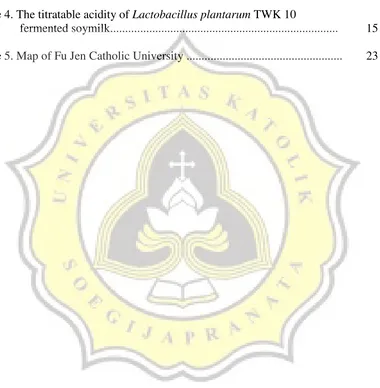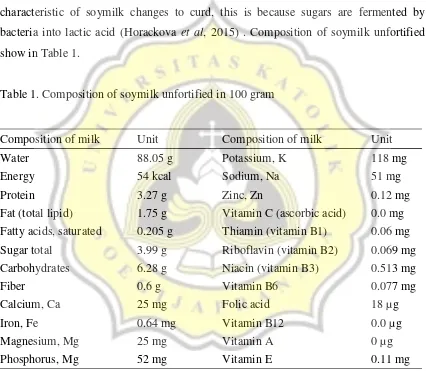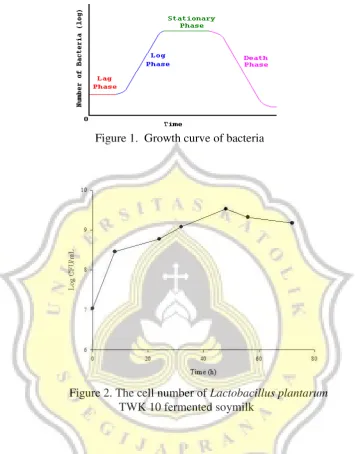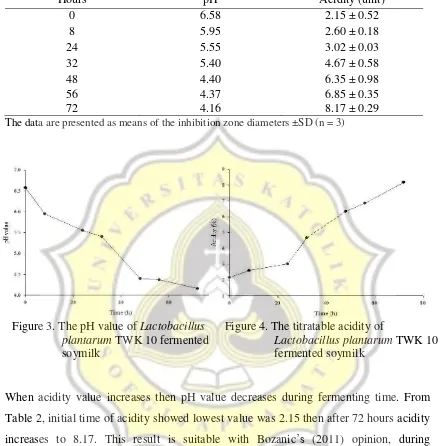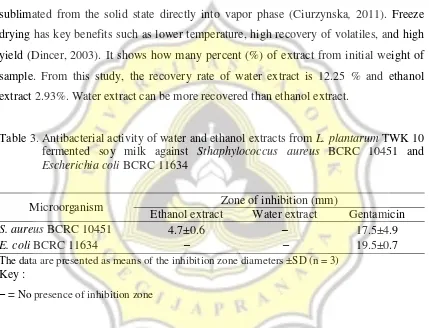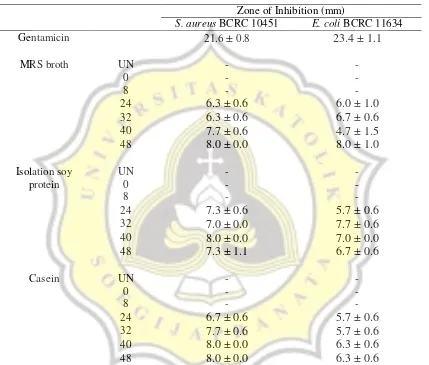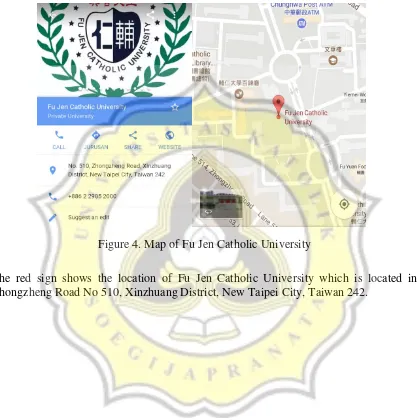1
STUDY ON THE CHARACTERISTIC ANALYSIS AND
ANTIBACTERIAL ACTIVITY OF Lactobacillus plantarum
TWK10 FERMENTED SOY MILK
Practical Training at Fu Jen Catholic University, Taipei, Taiwan
By:
ALFIANA SAVITRI Student ID : 14.I1.0116 Faculty: Agricultural Technology
This Practical training report has been approved and supported by examiner in Practical Training Exam on June 8th 2017
Semarang, June 8th 2017
Department of Food Technology Faculty of Agricultural Technology Soegijapranata Catholic University
Practical Training Advisor I Practical Training Advisor II
Dr. Tsung-Yu Tsai Dr. Ir. Lindayani, MP.
Dean
2
PREFACE
Praise the Lord because of His grace and blessing, the author had the opportunity to undergo the practical training and finished the report. This report is the complete accountability from the practical training which was done in Fu Jen Catholic University, New Taipei City, Taiwan that took place from January 4th until February 28th 2017.
During the training, the author did the research entitled: “Study on the Characteristic
Analysis and Antibacterial Activity of Lactobacillus plantarum TWK10 Fermented Soy
Milk”. This report was written as a requirement to acquire Bachelor Degree of Food Technology in Soegijapranata Catholic University, Semarang, Indonesia. The author would not be able to finish this task alone, and only by support and guidance given by people around the author that, this report could be finished. Special thanks for:
1. Allah SWT who always blessed, saved and guided the author in every step of practical training in Taiwan.
2. Dr.V. Kristina Ananingsih, ST, MSc. for giving the author the opportunity to join the internship program.
3. Dr. Tsung-Yu Tsai as author’s advisor for giving advices and supporting the author all the time during the practical training.
4. Dr. Ir. Lindayani, MP. as author’s advisor for taking care of the author during the practical training and making the report.
5. Joanne, Ruby, and Jessica who always helped the author to do the research. 6. My family, Mom, Dad, and Brother, who always support and cheer for the author. 7. Jessica, Denny, Irfan and all my friends that cannot be mentioned one by one who
always support the author during the practical training until finishing the report.
The author realizes that this report is still far from perfect and there are still many shortcomings due to the limitation of the author. However, the author hopes that this report can be an inspiration and provide useful information for all the reader.
Semarang, June 8th 2017
3
1.1.Background of Practical Training... 1
1.2.Purpose of Practical Training... 2
1.3.Time and Place of Practical Training... 2
2. INTITUTION PROFILE... 3
2.1.Fu Jen Catholic University... 3
2.2.Department of Food Science... 3
3. RESEARCH PROJECT... 4
3.1.Background of Research... 4
3.2.Literature Review... 5
3.2.1.Fermented Soy Milk... 5
3.2.2.Lactobacillus plantarum TWK 10... 6
3.2.3.Extraction... 7
3.2.4.Antibacterial Agents... 8
4. RESEARCH METHODOLOGY... 10
4.1.Materials... 10
4.2.Methods... 10
4.2.1.Sterilization of Soy Milk... 10
4.2.2.Fermentation of Soy Milk... 10
4.2.3.Microbial Count... 11
4.2.4.pH Analysis... 11
4.2.5.Acidity Value... 11
4.2.6.Extraction for Water and Ethanol... 11
4.2.7.Prepare for Antibacterial Test... 12
4
LIST OF TABLES
Table 1. Composition of soymilk unfortified in 100 gram... 6 Table 2. pH and acidity value of Lactobacillus plantarum TWK 10
fermented soymilk... 15 Table 3. Antibacterial activity of water and ethanol extracts from L. plantarum
TWK10 fermented soy milk against Sthaphylococcus aureus
BCRC 10451 and Escherichia coli BCRC11634... 16 Table 4. Antibacterial activity of Lactobacillus plantarum TWK 10
5
LIST OF FIGURES
Figure 1. Growth curve of bacteria... 14 Figure 2. The cell number of Lactobacillus plantarum TWK 10
fermented soymilk... 14 Figure 3. The pH value of Lactobacillus plantarum TWK 10
fermented soymilk... 15 Figure 4. The titratable acidity of Lactobacillus plantarum TWK 10
6
LIST OF APPENDIXES
Appendix 1. Place of Practical Training ... 23
7 technology has an important role to develop food industry. In this era we begin to place concerns about food in many aspects like product development, safety, packaging, nutrition, waste management, and also food microbiology.
Department of Food Technology, Soegijapranata Catholic University have a training program for student to improve their ability, knowledge, and skills. There are two programs available for this training, i.e student can improve their skill on food industry or do research on laboratory. Students who choose to train in the industry will get experience about how food technologist has the role about product development. Students who choose to do research will get experience on doing research in the university. Department of Food Science, Fu Jen Catholic University, Taiwan is choosing as one of University selected for research training in biotechnology and microbiology.
The title of the research was, “Study on the Characteristic Analysis and Antibacterial Activity of Lactobacillus plantarum TWK10 fermented soy milk”. The advisor of this
8
1.2. Purpose of Practical Training
This practical training have purpose :
a. To give experience to explore food in the research, so the student can implement the knowledge that they learned in the scientist world or real food industry.
b. To give an opportunity to adapt with new circumtances and neighborhood. c. To boarden the knowledge and experience of international exposure.
1.3. Time and Place of Practical Training
This practical training took place in department of food science, Fu Jen Catholic University, Xinzhuang District, New Taipei City, Taiwan. This research was conducted during 4th January to 28th February 2017.
9
2. INSTITUTION PROFILE
2.1. Fu Jen Catholic University
Fu Jen Catholic University (FJCU) is the first catholic university in Taiwan. Establish in 1925 by Benedictines of St. Vincent Archabbey in Latrobe, Pennsylvania and re-establish in 1961. Located in Zhongzheng Road, Xinzhuang District, New Taipei City, Taiwan which is strategic location and have an easy access to social activities on the capital of Taiwan. There are 1.942 staff academic, with 22.395 undergraduate students and 4.041 graduated students (master program). They provide 11 colleges with 48 department, 47 master program, 23 in service master program, 11 program doctoral program, and 16 departments in school of continuing education.
FJCU on the basis of truth, goodness, beauty, and holiness committed to a dialogue leading to the integration of Chinese culture and Christian faith, to academic research and the promotion of genuine knowledge, to the development of society and the advancement of humankind. Fu Jen have seven goals for their, there are human dignity, meaning of life, academic research, community awareness, dialogue with cultures, religious cooperation, and spirit of service.
2.2. Department of Food Science
Department of family studies and nutrition science was established in 1963. In 1971 nutrition science was combined with the food sciences as the department of nutrition and food science. And in 2006 food sciences became an individual department that
offers bachelor’s degree program and master’s degree program. With committed to
10
3. RESEARCH PROJECT
3.1. Background of Research
Antibacterial is a substance that can prevent, manage, and treat infection caused by bacteria and is known as antibiotics. Antibiotics in natural or synthetic form can interfere, inhibit the growth of bacteria, or kill the bacteria. Bacteria become resistant to antibacterial by natural or acquired mechanism. Natural resistant occur because of gene mutation and acquired resistant happen because adaptation of bacteria with conditional environment. This bacterial resistant represent a health problem. Hence we need to find new sources of antibacterial by testing active compound from plant or functional food (Stefanovic et al, 2012).
Soybean contains bioactive constituents like protein, isoflavone and trypsin inhibitor. Cooking soybean can cause degradation of protein and nutritive value by heating. The highest protein value is given by 4-10 % residual trypsin inhibitory activity in the heated soy milk (Yuan et al, 2008). Soymilk is an extract from soybean which is an emulsion
that contains soluble protein and other nutrition. It has the same appearance with cow’s
milk but it has a beanie flavor. It can be easily consume for lactose intolerant person.
The nutrition inside is not different with cow’s milk. To increase the nutrition value,
soymilk can be fermented by lactic acid bacteria like Lactobacillus plantarum TWK 10. By fermenting soymilk, it can increase the anti oxidative value and also increase activity of lactic acid bacteria on it. We know that lactic acid has the ability to surpress bacteria. It has prime functions for a strong antimicrobial activity against many spoilage bacteria and food–born pathogens. It also produces inhibitory compound like hydrogen peroxide, acetaldehyde, diacetyl, and bacteriocin. In biology, bacteriocin is an active protein which exhibits bactericidal effect against bacteria (Blazenka, 1995).
11
compound are methanol, ethanol, acetone, water, ethyl acetate and propanol. The right solvent makes maximum yield of compound optimal (Nazck & Shahidi, 2004).
This experiment are to analyze the characteristic of Lactobacillus plantarum TWK 10 fermented soymilk in certain condition and to investigate the antibacterial activity of
Lactobacillus plantarum TWK 10 fermented soymilk and antibacterial activity of L. plantarum TWK10 in different medium. Characteristic analysis involves recovery of water and ethanol extract, cell number, pH value, and titratable acidity. The inhibition zone diameters determine the antibacterial activity on sample. For different medium, there are MRS broth, Isolation soy protein, and Casein. We used E. coli for gram negative bacteria and S. aureus for gram positive bacteria.
3.2. Literature Review
3.2.1. Fermented Soy Milk
Soymilk is a beverage from soybean. It contains of high vegetable protein, unsaturated fatty acid, soluble and insoluble dietary fibers and isoflavone (Božanić et al, 2011). Soymilk was extracted from soybean and through pasteurization process. Extract of soybean have a similar appearance with cow’s milk but it has a beany or soy flavor. Therefore, soymilk can be used as alternative for dairy product. It has similar protein content (3.5-4.0%) with cow’s milk and pattern of amino acid, has 60-90% nutritional
value of cow’s milk. Soymilk is deficient in sulfur containing amino acid. Soymilk contains protein amino acid Arginine and Glycine, that can reduce cholesterol. Soymilk can be a good alternative for people who are allergic to cow’s milk. It contains free lactose and easy for digestion. Soymilk is suitable for diabetic people (Ahaniah et al,
2014) .
12
Lactobacillus. We usually know it as Lactic Acid Bacteria (LAB). Bifidobacterium is another main microorganism that is currently used (Božanić et al, 2011).
LAB is a gram positive bacteria, do not have ability to form spore, and have coccus or rod shape. It ferment all carbohydrate into lactic acid. Soymilk contains galactooligosaccharides that can be used as prebiotic for probiotic. But fermentation can reduce galactooligosaccharides content in soymilk. During fermentation, hydrolysis of milk protein, decrease of pH, and increase of viscosity occurs. After fermentation, the characteristic of soymilk changes to curd, this is because sugars are fermented by bacteria into lactic acid (Horackova et al, 2015) . Composition of soymilk unfortified show in Table 1.
Table 1. Composition of soymilk unfortified in 100 gram
Composition of milk Unit Composition of milk Unit
Water 88.05 g Potassium, K 118 mg
Energy 54 kcal Sodium, Na 51 mg
Protein 3.27 g Zinc, Zn 0.12 mg
Fat (total lipid) 1.75 g Vitamin C (ascorbic acid) 0.0 mg Fatty acids, saturated 0.205 g Thiamin (vitamin B1) 0.06 mg
Sugar total 3.99 g Riboflavin (vitamin B2) 0.069 mg
Carbohydrates 6.28 g Niacin (vitamin B3) 0.513 mg
Fiber 0.6 g Vitamin B6 0.077 mg
Calcium, Ca 25 mg Folic acid 18 µg
Iron, Fe 0.64 mg Vitamin B12 0.0 µg
Magnesium, Mg 25 mg Vitamin A 0 µg
Phosphorus, Mg 52 mg Vitamin E 0.11 mg
[Source: USDA Nutrient Database for Standard Reference 2016]
3.2.2. Lactobacillus plantarum TWK 10
13
acid, ethanol, acetic acid, and carbon dioxide in selective substrate and under certain condition (Siezen & Johan, 2011). It is acid and salt tolerant. Lactobacillus plantarum
TWK10 have potential effect in probiotics: its metabolites inhibit pathogen growth, blocks melanin production, suppresses serum cholesterol, exhibits anti-obesity effects, modulates the immune system, reduce the risk of atherosclerosis and related cardiovascular disease when used to ferment in soymilk (Liu et al, 2016). This bacteria is considered as a safe probiotic and has become a current interest for researcher especially in food industry. As a probiotic component, it can help to limit the amount of pathogenic bacteria and decrease negative impacts on humans. L. plantarum TWK 10 strain can be found in Taiwanese fermented cabbage (Liu, 2016). Lactic acid bacteria are typically bacteria that can survive in wide ranges of temperature and pH in some easy spoilage food. L. plantarum that produce lactic acid has antibacterial activity and can be used as preservative in food product. L. plantarum have more effectiveness in inhibiting some microorganism than preservative like sodium benzoate and potassium sorbate (Crowley et al., 2012).
3.2.3. Extraction
14
extract tannin, polyphenol, flavonol, terpenoid, sterol, alkaloid, polyacetylene, and propolis. Thus water which has characteristic as polar solvent can dissolve Sugar, amino acid, saponin, tannin, lectine, terpenoid, anthocyanin, starches, and polypeptide (Gupta
et al, 2012). To move molecule from high concentration to low concentration it needs driving force. Shaking is one of driving force that has principle the increasing of driving force followed by increasing of mass transfer rate and make consequently prompted diffusion rate of solute (Kain et al, 2009). Sampath (2013) study present that shaking can give effect on yield increasing of phenolic compound extraction until maximum.
3.2.4. Antibacterial Agents
Antibacterial agent is used to help preventing spoilage caused by bacteria. Antibacterial agent can be differentiated by their mechanism of action such as antibacterial agent can inhibit growth of cell wall, inhibit synthesis of protein, and inhibit synthesis of nucleic acid cell. Activity of antibacterial agent can divided into 2 various there are bacteriostatic and bactericidal. Bacteriostatic is antibacterial that can inhibit growth of bacteria but cannot kill the pathogen, but bactericidal can kill pathogens (Brooks et al., 2013)
Antibacterial activity test performed with diffusion and dilution method. Diffusion test is performed by measuring diameter of clear zone. This clear zone showed inhibition of bacterial growth by antibacterial agent. Mueller Hinton Agar (MHA) is used for antimicrobial testing by diffusion test. This agar commonly performed on aerobic and facultative anaerobic bacteria. MHA contains beef extract (2 gram), acid hydrolysate of casein (1.75 gram), and starch (1.5 gram) (Wayne, 2006).
15
diffuse into agar and work to inhibit growth of the test microorganism. The result is determined by measuring inhibition zone or clear zone (Salama et al, 2010).
Agar plug diffusion is almost similar with agar disc. It is often used to know the antagonism characteristic between microorganisms (Jiménez et al, 2005). Agar plate media is inoculated with test microorganism. During incubation, diffusion happens when microbial cell secrete molecule and their secretion diffuse into agar medium. Then agar plot or cylinder plug is taken aseptic and deposited onto the surface of the other agar media that previously inoculated with the test microorganism. Antibacterial activity can be detected by the presence of inhibition zone around the agar media. It happens because there is a diffusion of substance from agar plot into agar media (Balouiri et al., 2016).
Agar well diffusion method is used to evaluate antibacterial activity of microbial or plant extract (Magaldi et al., 2004). This method have a similarity with disk diffusion, inoculated microorganism is spreading on surface of agar plate. Well with diameter of 6–8 mm is made with sterile tip or pipette plastic. The amount of well is made as needed, each well filled with 20–100 µl liquid extract or antibacterial agent. Agar plate is incubated under certain condition depending on condition of microorganism. Diffusion happened when antibacterial diffuse into agar plate and affect the growth of microorganism. It can inhibit the growth of microorganism by showing a clear zone (Balouiri et al., 2016).
16
4. RESEARCH METHODOLOGY
4.1. Materials
The materials that used were soymilk, Lactobacillus plantarum TWK10,
Staphylococcusaureus BCRC 10451, Escherichiacoli BCRC 11634, gentamicin, MRS,
MHA (Mueller Hinton Agar), NaCl 0.85%, NaOH 0.1N, ethanol, dimethylsulphoxide (DMSO), water, phenolphthalein indicator, micropipette, tips, tubes, plate dish, inoculating loop, 0.22µm syringe filter, sterile cotton bud, sterile bottle, centrifuge bottle, centrifuge, vortex, burette, water bath, shaker water bath, refrigerator, freezer, incubator, laminar flow, rotary evaporator, pH meter (glass electrode pH), and freeze drying.
4.2. Methods
4.2.1. Sterilization of Soy Milk
Pour 1L soymilk into sterile bottle. Put it in the water bath with temperature 93oC for 1 hour. Then let it cool down until it reached room temperature and store at 4°C in the refrigerator (Yuan et al, 2008).
4.2.2. Fermentation of Soy Milk
17
4.2.3. Microbial Count
Plate that has been incubated was taken out. Do observation by counting the white spot in each dilution. Then make it into curve. It will show microbial rate on living.
4.2.4. pH Analysis
pH analysis was measured using glass electrode pH meter. It was calibrated with liquid that have pH 4, 7, and 10. The electrode was dipped in the sample till number of pH showed constantly and recorded it. Each sample was tested three times. pH meter is washes by pure water with very change of samples (Khodke et al, 2015).
4.2.5. Acidity Value
Each sample will be tested three times. 10ml of fermented soy milk was put in the Erlenmeyer with 3–4 drops of Phenolphthalein indicator. Burette was filled with 0.1 NaOH as titrant. The solution was titrated until the color of solution change into pink. Then burette reading was recorded as acidity value (Khodke et al, 2015).
4.2.6. Extraction for Water and Ethanol
18
4.2.7. Prepare for Antibacterial Test
19
5. RESULT AND DISCUSSION
In this study, soymilk was fermented by Lactobacillus plantarum TWK 10. It took 72 hours for fermentation at 37oC. Lactobacillus is a microbe that can produce lactic acid. It is a rod shape, gram positive bacteria. It is commonly found in gastrointestinal tracts, and various food products. Lactobacillus can grow at temperature of 15–45oC and in low pH. This bacteria works by changing sugar into lactic acid, ethanol, and carbon dioxide under certain condition. It can grow with or without presence of oxygen (Kleerebezem et al. 2003).This bacteria is interesting because it has safe probiotic characteristic that can help limit pathogen bacteria in the gastrointestinal tract. Soymilk contain high protein from extracted soy bean and it is free of lactose.
20
Soymilk which has been fermented for 72 hours was then tested by pH meter (Table 2, Figure 3, and Figure 4), of the initial pH is 6.58. During fermentation until at the end of fermentation there is a decrease in pH value to 4.16. During fermentation time, bacteria
Lactobacillus plantarum TWK10 produced a lactic acid that can increase acidity and affect pH value. It also happen to acidity value, there is an increase during fermentation.
Figure 2. The cell number of Lactobacillus plantarum TWK 10 fermented soymilk
21
Table 2. pH and acidity value of Lactobacillus plantarum TWK 10 fermented soymilk
Hours pH Acidity (unit)
The data are presented as means of the inhibition zone diameters ±SD (n = 3)
When acidity value increases then pH value decreases during fermenting time. From Table 2, initial time of acidity showed lowest value was 2.15 then after 72 hours acidity increases to 8.17. This result is suitable with Bozanic’s (2011) opinion, during fermentation time, there are changes of hydrolysis in milk protein that causes a decrease in pH value. When pH value decreased, there is an increase in acidity value.
22
need for further separation process. Evaporation is one of further separation processes. This process is used in condition that substance has very high volatile and solvent should have a low boiling temperature and low heat of evaporation. It is used to accelerate process to get pure substance. Evaporation can use rotary evaporator. Crystallization is another method to remove all water content by cooling substance in very low temperature and make substance falls out. Usually freeze drying is used in this process. Freeze drying also known as lyophilization, which is a drying process in which the solvent or the suspension medium is crystallized at a low temperature and thereafter sublimated from the solid state directly into vapor phase (Ciurzynska, 2011). Freeze drying has key benefits such as lower temperature, high recovery of volatiles, and high yield (Dincer, 2003). It shows how many percent (%) of extract from initial weight of sample. From this study, the recovery rate of water extract is 12.25 % and ethanol extract 2.93%. Water extract can be more recovered than ethanol extract.
Table 3. Antibacterial activity of water and ethanol extracts from L. plantarum TWK 10 fermented soy milk against Sthaphylococcus aureus BCRC 10451 and
Escherichia coli BCRC 11634
Microorganism Zone of inhibition (mm)
Ethanol extract Water extract Gentamicin
S. aureus BCRC 10451 4.7±0.6 – 17.5±4.9
E. coli BCRC 11634 – – 19.5±0.7
The data are presented as means of the inhibition zone diameters ±SD (n = 3) Key :
– = No presence of inhibition zone
23
controlling growth of bacteria. The inhibition zone for S. aureus is 17.5±4.9 mm and for
E. coli is 19.5±0.7 mm. Gentamicin is a bacterial antibiotic which can affects bacterial growth by specific inhibition. Gentamicin is effective to prevent infection of gram negative and positive bacteria such as E. coli and Staphylococcus sp.
Table 4. Antibacterial activity of Lactobacillus plantarum TWK 10 in different medium
Zone of Inhibition (mm)
The data are presented as means of the inhibition zone diameter ±SD (n = 3) Keys:
UN = Unfermented
– = No presence of inhibition zone
24
25
6. CONCLUSION AND SUGGESTION
6.1.Conclusion
Water extract of Lactobacillus plantarum TWK 10 fermented soymilk more recovered than ethanol extract. There are increasing of cell number during fermentation followed with decreasing of pH value and increasing of acidity value. Activity of antibacterial on Lactobacillus plantarum TWK 10 fermented soymilk can
against S. aureus BCRC 10451 with 4.7±0.6 mm of inhibition zone on ethanol extract. Isolate soy protein and casein are the best medium that can against S. auerus
BCRC 10451 in 40 hours incubation time with 8.0±0.0 mm of inhibition zone. For against E. coli BCRC 11634 the best medium is MRS broth in 48 hours of incubation with 8.0±1.0 mm of inhibition zone.
6.2.Suggestion
26
7. REFERENCES
Ahanian, B., R, Pourahmad., And Fardin, M. 2014. Effect of Substituting Soy Milk Instead of Skim Milk on Physicocgemical and Sensory Properties of Sesame Ice Cream. Indiana Journal Science. Vol 7(1):1134-1143.
Balouiri, M., Sadiki, Moulay., and Saad Koraichi Ibnsouda. 2016. Methods for in vitro evaluating antimicrobial activity: A review. Journal of Pharmaceutical Analysis. Vol 6(2):71-79.
Božanić, R., Sandy, L., and Irena J. 2011. Optimising Fermentation of Soymilk with Probiotic Bacteria. Journal of Food Science. Vol 1(1):51-56.
Brooks, G.F., Carroll, K.C., J. Butel., Morse, Stephen A., and Timothy M. 2013.
Medical Microbiology. 26th edition. a Lange medical book.
Cacace, J.E., and G. Mazza. 2003. Mass Transfer Process During Extraction of Phenolic Compounds from Milled Berries. Journal of Food Engineering. Vol 59(4):379-389.
Ciurzynska, A., and Andrez, L. 2011. Freeze Drying-Aplication in Food Processing and Biotechnology-A Review. Polish Journal of Food and Nutrition Science. Vol 61(3):165-171.
Crowley, S., Mahony, J. and Van Sinderen, D. 2012. Comparative analysis of two antifungal Lactobacillus plantarum isolates and their application as bioprotectants in refrigerated foods. Journal of Applied Microbiology. Vol 113(6):1417-1427.
Dincer I,. 2003. Refrigeration System and Application. John Willey & Sons. England.
Gupta, A., Madhu, N., and Vijay, K. 2012. Modern Extraction Methods For Preparation of Bioactive Plant Extract. International journal of applied and natural science.
Vol 1(1):8-26.
Harbone, J.B. 1984. Phytochemical Methods: A guide to modern technique of plant analysis. Chapman and Hall. London.
27
Jiménez-Esquilín, A.E. and Roane, T.M. 2005. Antifungal activities of actinomycete strains associated with high-altitude sagebrush rhizosphere. Journal of Industrial Microbiology and Biotechnology. Vol 32(8):378-381.
Kain, R.J., Chen, Z., Sonde, T.S., and Abukpawoh, J.C. 2009. Study of the control variable on the extraction of peanut protein isolates from peanut meal (Arachis hypogaea L). Journal of food Technology. Vol 4(1):47-55.
Khodke, S., Kiran, S., and Govind B.Y. 2015. A Study on the Storage of Sterilized Soy Milk. International journal of farm science. Vol 4(4):166-179.
Kleerebezem, M., Jos, Boelhrost., and Richard, V.K. 2003. Complete genome sequence of Lactobacillus plantarum WCFS1. Proceedings of the National Academy of Sciences of the United States of America. Vol 100(4):1990–1995.
Liu, T.H., Jiachi, C., and Tsung, Y.T. 2016. Effect of Lcatobacillus plantarum
TWK10-Fermented Soymilk on Deoxycorticosterone Acetate-Salt-Induced Gypertension and Associated Dementia in Rats. Nutrient. Vol 8(260):1-18.
Magaldi, S., S, Mata-Essayag., and C, Hartung D.C. 2004. Well diffusion for antifungal susceptibility testing. International Journal of Infectious Diseases. Vol 8(1):39-45.
Naczk, M., and Fereidoon, S. 2004. Extraction and Analysis of Phenolic in Food.
Journal of Chromatography A. Vol 1054(1):95-111.
Pushparaj, A., Raubin, R.S., and T, Balasankar. 2014. An Antibacterial Activity of the Green Seaweed Caulerpha Sertulariodes Using Five Different Solvent.
International journal of chemistry technology research. Vol 6(1):1-5.
Salama, H.M.H., and Najat, M. 2010. Antimicrobial Activity and Phytochemical Analyses of Polygonum aviculare L. (Polygonaceae), Naturally Growing in Egypt. Saudi journal of biological science. Vol 17(1):57-63.
Sampath, M. 2013. Optimization of the Extraction Process of Phenolic Antioxidant From Polyalthia Longifolia (Sonn.) Thawaites. Journal of applied pharmaceutical science. Vol 3(2):148-152.
28
Siezen, R.J., Johan, E.T., and Van H.V. 2011. Genomic diversity and versatility of Lactobacillus plantarum, a natural metabolic engineer. Microbial cell factories. Vol 10(1): 1-13.
Wayne, P. 2006. Performance Standards for Antimicrobial Disk Susceptibility Test; Approved Standard. Ninth edition. Vol 26(1):1-35.
29
8. APPENDIX
Appendix 1. Place of Practical Training
The practical training is conducted in Department of Food Science, Fu Jen Catholic University at Figure 4.
Figure 4. Map of Fu Jen Catholic University
30
Appendix 2. List of Attendance

